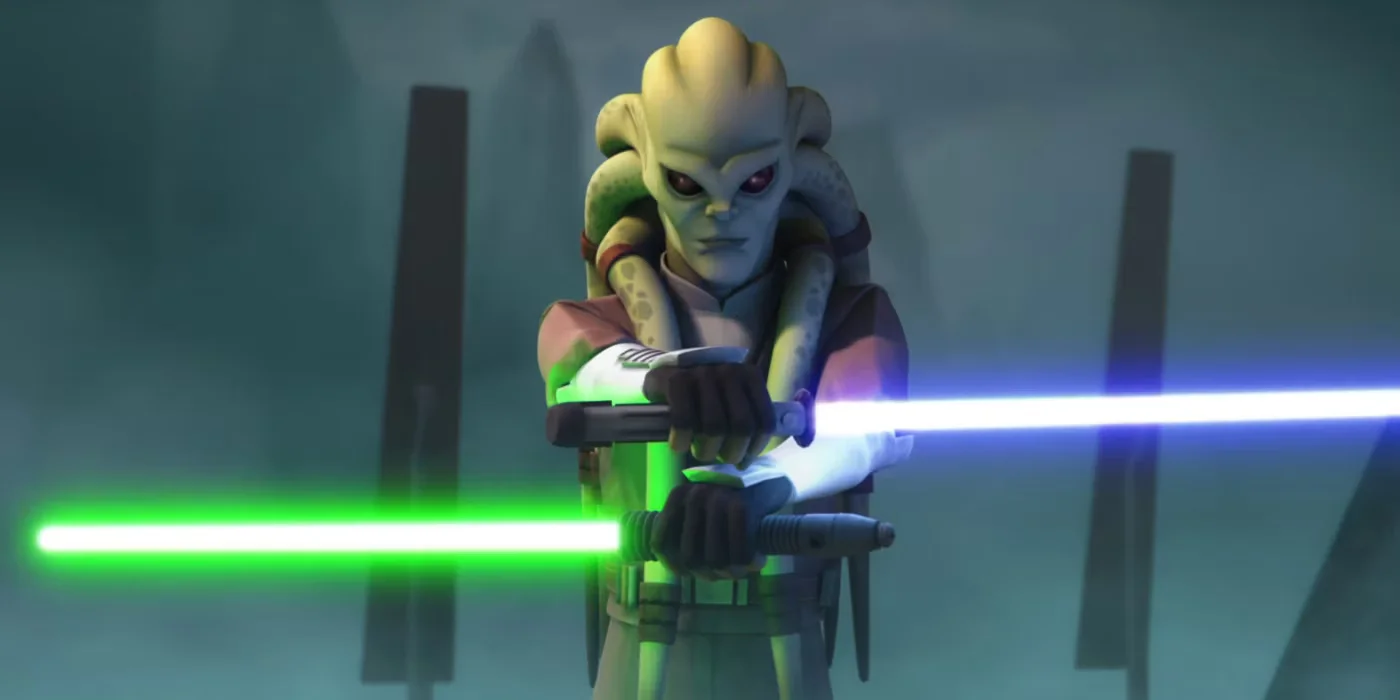Lightsaber combat is a cornerstone of the Star Wars galaxy, where the skilled use of this iconic weapon distinguishes the Jedi from the Sith. These forms of combat are not just about swinging a lightsaber but involve intricate techniques and styles that each warrior masters. There are seven main lightsaber combat forms, each with unique characteristics and strategies tailored to various combat scenarios.
The history of lightsaber combat dates back to the ancient Jedi Order, where different forms were developed to balance offensive and defensive tactics. Characters like Count Dooku, Darth Vader, and even young Padawans demonstrate distinct styles, showcasing how varied and specialised these forms can be. The evolution of these techniques shows the deep connection between a Jedi or Sith and their lightsaber, an extension of their philosophical and physical training.
The seven lightsaber forms range from the straightforward and beginner-friendly Shii-Cho to the highly acrobatic and aggressive Ataru. Each form reflects the wielder’s combat preferences and often, their philosophical stance. By mastering these forms, a combatant can adapt to various threats across the galaxy, from one-on-one duels to large-scale battles.
Key Takeaways
- Seven main forms of lightsaber combat, each unique and specialised.
- The history and evolution of these forms are deeply rooted in Jedi and Sith traditions.
- Each lightsaber form is tailored to the wielder’s combat style and philosophy.
Historical Overview
Lightsaber combat has evolved significantly over thousands of years, influenced by both the Jedi and Sith Orders. These transformations reflect the practical and philosophical shifts in the galaxy’s history.
Origins of Lightsaber Combat
The origins of lightsaber combat can be traced back over 7,000 years before the Battle of Yavin, marking the early days of the Jedi Order. Initially, Jedi used simple weapons like swords. The introduction of lightsabers revolutionised their approach to combat.
Lightsaber techniques began as adaptations of earlier martial arts, modified to accommodate the unique properties of the weapon. Proficiency in these techniques relied heavily on one’s connection to the Force, enhancing agility, precision, and reflexes.
Evolution in the Galaxy
As the galaxy evolved, so did lightsaber combat. Distinct forms emerged, each with specific tactical advantages. The Sith, in their constant conflict with the Jedi, also developed unique combat styles. Notable forms include Form II: Makashi, favoured for its duelling precision, and Form V: Shien / Djem-So, known for its defensive and counter-attacking strengths.
These forms were not static; they evolved alongside advancements in technology and shifts in alliances within the galaxy. Mastery of multiple forms became crucial for Jedi and Sith alike, ensuring adaptability in various combat scenarios.
Through centuries of conflict and peace, lightsaber combat continues to symbolise the enduring struggle between the light and dark sides of the Force.
The Seven Forms of Lightsaber Combat
The seven lightsaber combat forms in Star Wars each provide unique strategies, techniques, and principles for wielding a lightsaber, catering to different combat needs and preferences. These forms have been honed by Jedi and Sith alike, each one with specific strengths and weaknesses.
Form I: Shii-Cho
Form I: Shii-Cho is the oldest and most foundational lightsaber combat form. Developed by the ancient Jedi Order, Shii-Cho focuses on basic offensive and defensive maneuvers. Its techniques include wide, sweeping strikes aimed at disarming opponents rather than injuring them.
The simplicity of Shii-Cho makes it versatile and accessible to all practitioners. It is often the first form learned by Jedi younglings due to its straightforward approach. By mastering Form I, a Jedi gains essential skills that form the basis of more advanced lightsaber combat techniques.
Form II: Makashi
Form II: Makashi, also known as “The Way of the Ysalamiri”, is the form of choice for lightsaber-to-lightsaber combat. Developed as a response to the rise in Sith adversaries, Makashi is characterised by its precise, fluid motions and emphasis on balance and footwork.
Makashi practitioners, such as Count Dooku, favour elegance and efficiency over brute strength. The form’s focus on controlled attacks and parries makes it highly effective in duels. Its linear movements provide a counter to traditional, powerful swings, offering practitioners a refined and strategic approach to combat.
Form III: Soresu
Form III: Soresu, also known as “The Way of the Mynock”, excels in defensive techniques. It was created to withstand blaster fire and is characterised by tight, efficient movements and a solid guard stance.
Practitioners of Soresu, such as Obi-Wan Kenobi, rely on patience and endurance, waiting for their opponent to make a mistake. The primary goal is to minimise exposure to attacks, making Soresu ideal for prolonged engagements. Its defensive nature requires a high degree of focus and energy conservation, making the practitioner nearly impenetrable.
Form IV: Ataru
Form IV: Ataru, known as “The Way of the Hawk-Bat”, is an acrobatic and aggressive form that integrates Force-enhanced movements. Ataru practitioners utilise speed, agility, and strength to overwhelm opponents with rapid, high-energy attacks.
Notable Ataru users, like Yoda and Qui-Gon Jinn, employ flips, spins, and leaps to maintain a dynamic and unpredictable offensive. The form is highly physical, demanding peak conditioning from its practitioners. While effective against single opponents, Ataru can be less effective in confined spaces or against multiple adversaries.
Form V: Shien / Djem So
Form V: Shien / Djem So, also called “The Way of the Krayt Dragon“, is a dual-discipline form that focuses on counterattacks. Shien is designed for deflecting blaster bolts back at attackers, while Djem So is tailored for lightsaber duelling with an emphasis on strength.
Practitioners like Anakin Skywalker harness both disciplines to create a blend of defensive resilience and offensive power. Shien’s broad strokes are supplemented by Djem So’s powerful strikes, allowing the practitioner to dominate the battlefield through both defence and attack.
Form VI: Niman
Form VI: Niman, also known as “The Way of the Rancor”, is a hybrid form that combines elements from previous styles. Known as the “Diplomat’s Form”, Niman allows practitioners to balance lightsaber combat with other Force abilities.
Jedi who specialise in Niman, such as Exar Kun, favour its well-rounded approach that does not overly tax the practitioner. The versatility of Niman makes it adaptable to various combat scenarios, though it lacks the focused specialisation of other forms. This makes it suitable for Jedi negotiators who may need to switch between diplomacy and combat seamlessly.
Form VII: Juyo / Vaapad
Form VII: Juyo / Vaapad is the most aggressive and unpredictable lightsaber form. Practised by Jedi like Mace Windu, it incorporates intense and ferocious attacks. Juyo, characterised by its wild and erratic movements, demands both physical and mental strength.
Vaapad, a variant developed by Windu, channels a user’s inner darkness, allowing them to edge closer to the dark side without succumbing to it. This form requires mastery and careful balance, making it highly effective yet extremely dangerous for the user if not properly controlled.
Technical Aspects of Lightsaber Combat
Lightsaber combat is an intricate art that involves precise body movements, firm stances, effective grips, and fluid combinations of attacks and defences. This section breaks down the essential components that define proficient lightsaber combat.
Stances and Grips
Stances serve as the foundation of lightsaber combat, dictating a combatant’s readiness and balance. Typical stances include the aggressive forward stance, where the lead foot is pointed towards the opponent and the back foot provides stability, and the more defensive sideways stance, which reduces the target area.
Grips are equally important. A single-handed grip is often seen in Makashi, favouring elegance and precision. For more power-driven forms like Djem So, a two-handed grip is preferred to enhance strength and control. Mastery of both stances and grips allows a combatant to adapt to different combat scenarios swiftly.
Attack Types and Defensive Moves
Lightsaber attacks can range from basic strikes to elaborate slashes. Overhead slashes deliver powerful blows but leave the user vulnerable if not timed correctly. Horizontal strikes are versatile, capable of targeting multiple enemy areas, while thrusts focus on piercing defences with precision.
Defensive moves require equal skill. Parries deflect incoming attacks, redirecting their energy away from the combatant. Blocks are crucial against heavier strikes, where the lightsaber blade is used to absorb and counteract force. A master of defensive moves can turn defence into offence, creating opportunities for ripostes.
Footwork and Body Movement
Footwork underpins every action in lightsaber combat. Sliding steps allow a user to maintain balance while attacking or defending. Sidesteps and pivots create angles of attack or escape from dangerous positions. Efficient footwork offers both offensive and defensive advantages.
Body movement complements footwork. Rotational motions are utilised to add power and fluidity to strikes. Leaning and dodging enable a combatant to evade attacks while maintaining their stance. Coordinated body movement ensures that actions are smooth and energy-efficient, maximising combat effectiveness.
Combination and Sequences
Combining attacks and defensive moves into sequences is an advanced skill that distinguishes adept combatants. Chaining attacks, such as transitioning from a high slash to a low sweep, forces the opponent to constantly adjust their defence. Effective combinations keep the opponent off-balance and create openings.
Sequences are meticulously practiced to ensure fluidity and unpredictability. Feints and disarms can be incorporated to confuse and outmanoeuvre the opponent. Practicing these combinations allows a lightsaber user to execute complex manoeuvres instinctively during battle, enhancing their overall combat efficiency.
Combat Styles and Practitioners
Lightsaber combat styles offer Jedi and Sith warriors ways to master different forms of fighting. Various approaches, such as single-bladed combat, dual-wielding, and reversed grip techniques, provide unique strategic advantages in battle.
Single-Bladed Combat
Single-bladed combat is the most traditional and widely used form of lightsaber fighting. It provides a balanced approach, combining offence and defence. Popular among Jedi such as Obi-Wan Kenobi and Anakin Skywalker, the single-blade style allows for a versatile combat strategy.
Styles:
- Form I: Shii-Cho – Emphasises wide, sweeping motions.
- Form II: Makashi – Focuses on precision and lightsaber dueling, used by Count Dooku.
- Form III: Soresu – Prioritises defence and has been mastered by Jedi like Obi-Wan Kenobi.
Dual-Wielding and Jar’Kai
Jar’Kai, the style of wielding two lightsabers simultaneously, demands exceptional coordination and skill. It enhances offensive capabilities but requires intense training. Known practitioners include Ahsoka Tano and Asajj Ventress.
Advantages:
- Increased attacking options and speed.
- Better control over offensive engagements.
Disadvantages:
- Higher energy expenditure and difficulty in mastering.
Reverse Grip Techniques
Reverse grip techniques involve wielding the lightsaber with the blade pointing downwards. This method is seen with characters like Ahsoka Tano in her later battles. The reverse grip can surprise opponents and offer unique angles of attack.
Key Points:
- Provides unique defensive manoeuvres.
- Requires adaptation and exceptional dexterity.
Unique Variations
Unique variations of lightsaber combat arise from individual creativity and adaptation to particular fighting styles. Kylo Ren’s crossguard lightsaber introduces new defensive techniques, while lightsaber pikes and whips provide distinct tactical advantages.
Examples:
- Crossguard Lightsaber: Adds extra defensive elements.
- Lightsaber Pike: Extends reach and provides staff-like combat opportunities.
- Lightwhip: Offers flexibility and unpredictability in battle.
These variations emphasise personal adaptation and continuous evolution in lightsaber combat forms.
Famous Duelists and Their Techniques
Certain duelists in the Star Wars universe are renowned for their exceptional mastery of lightsaber combat forms. This section highlights the unique techniques and the combat prowess exhibited by these famous figures.
Masters of the Force
Yoda:
Yoda’s lightsaber style, Ataru (Form IV), emphasises agility and acrobatics. Despite his small stature, Yoda’s energetic leaps and swift attacks kept opponents off-balance. His mastery of the Force complemented his combat skills, making him nearly invincible.
Mace Windu:
Mace Windu’s Vaapad (Form VII) is a variant of Form VII that channels intense and sometimes dark emotions into combat, without succumbing to the Dark Side. This aggressive and unyielding technique made him a formidable opponent, even against Sith Lords.
Qui-Gon Jinn:
Qui-Gon Jinn primarily utilised Ataru, focusing on aggressive strikes and quick movements. His ability to anticipate an opponent’s moves, while leveraging the Force for bursts of speed, highlighted his tactical mind in battle.
Sith Lords and Dark Side Adepts
Darth Sidious:
Darth Sidious, skilled in multiple forms, often preferred Juyo (Form VII) for its offensive capabilities. His lightning-fast attacks, combined with powerful Force abilities, made him one of the most dangerous Sith in the galaxy.
Darth Maul:
Darth Maul often wielded a double-bladed lightsaber with Juyo techniques. The aggressive and relentless attacks, coupled with his acrobatic prowess, made him a fearsome duelist. His unique weapon required a highly skilled and disciplined approach to combat.
Count Dooku:
Count Dooku’s Makashi (Form II) focused on precision and efficiency. Known for its duelling superiority, Makashi allowed Dooku to hold his own against multiple opponents. His aristocratic background and fencing style gave him an elegant yet deadly edge.
Jedi Knights and Heroes
Obi-Wan Kenobi:
Obi-Wan Kenobi’s mastery of Soresu (Form III) underlined his defensive strategies. This form emphasised tight, controlled movements and energy conservation, allowing Kenobi to outlast and outmanoeuvre his foes.
Anakin Skywalker:
Anakin Skywalker heavily relied on Djem So (Form V), which focused on strong offensive and defensive capabilities. Known for his aggressive and determined fighting style, Anakin’s use of powerful, dominating blows became his hallmark.
Ahsoka Tano:
Ahsoka Tano utilised Shien (Form V) and later Jar’Kai, fighting with two lightsabers. Her technique involved deflection of blaster bolts and swift, overwhelming strikes. Her agility and adaptability made her a skilled and versatile duelist.
Luke Skywalker:
Luke Skywalker adopted Form V in his journey to become a Jedi Master. Over time, he blended different techniques, learning from various Jedi texts and honing a more balanced and adaptive fighting style in his fight against the Sith.
Each of these duelists showcased unique strategies and skills in their respective combats, making significant impacts on the Star Wars saga.
Tactical Application
In lightsaber combat, different tactical applications enhance both defence and offence. Understanding how to combat blasters, engage in team strategies, and use the environment can provide significant advantages.
Lightsaber Vs Blaster
Combating blasters requires agility and precision. Jedi and Sith utilise their lightsabers to deflect blaster bolts back at their sources.
Form III: Soresu specialises in blaster deflection, where the wielder uses minimal movement to deflect multiple shots, conserving energy. They position themselves strategically to protect vital areas and focus on subtle hand movements.
A skilled practitioner can turn an opponent’s blaster fire against them, creating openings for a counterattack. Form V: Shien/Djem So also emphasises redirecting blaster bolts but with a stronger offensive approach, often launching a countering strike right after deflection.
Team Strategies and Group Battles
In group scenarios, Jedi and Sith must coordinate their attacks and defences. Each member typically adopts a specific form to complement the others.
Form I: Shii-Cho focuses on battling multiple opponents and is used for sweeping attacks to manage groups. Jedi often position themselves to cover each other’s blind spots and create a defensive net that blasters or enemy sabres find hard to penetrate.
In offensive manoeuvres, pairing Form III: Soresu users to handle defence with more aggressive forms like Form VII: Juyo/Vaapad helps combine strong impenetrable shields with powerful strikes. Effective communication and synchronisation are crucial in these combat scenarios.
Environment and Terrain Advantages
The combat environment can drastically impact the effectiveness of a lightsaber user. Utilising terrain for tactical advantages means adapting one’s combat style to the surroundings.
Form IV: Ataru incorporates acrobatics and agile movements, making it ideal for uneven or complex terrains. Jedi using Ataru can leap from trees, walls, or other structures to gain high ground or surprise an opponent.
Narrow corridors favour Form II: Makashi, which prioritises precise and controlled movements, lessening the chance of hitting walls when duelling. Similarly, using terrain for cover against blaster fire or channelling enemies into tight spaces where their numbers count less can be vital strategies.
Using available elements, from natural landscapes to urban settings, ensures a combatant maximises both defensive and offensive potential.
Physical and Mental Preparation
Effective lightsaber combat requires both rigorous physical training and profound mental discipline. Padawans, knights, and masters alike follow strict regimes to optimise their abilities and maintain focus.
Training Regimes
Training regimes for lightsaber combat vary depending on the rank and experience of the Force user. Padawans often begin with basic drills that focus on Form I: Shii-Cho, mastering the fundamental movements and strikes.
Knights and Masters advance to more complex forms such as Makashi and Ataru, incorporating acrobatics and telekinesis exercises. Strength and endurance training play a crucial role, enhancing agility and reaction times. Daily sparring sessions are essential, allowing practitioners to apply techniques in real combat scenarios.
Mental Discipline and Focus
Equally important as physical training is the cultivation of mental discipline. Practitioners must maintain focus, calm, and control over their emotions. Techniques such as meditation and mindfulness help Jedi manage stress and avoid succumbing to inner darkness or rage.
Masters often teach padawans the importance of balance, ensuring they can channel the Force effectively during combat. This mental preparedness is vital for performing advanced skills like telekinesis and blending different forms seamlessly. By honing their mental fortitude, Jedi can remain resilient and adaptable in the face of adversity.
Adaptations and Legacy
The legacy of lightsaber combat forms extends beyond the Star Wars universe, influencing various aspects of fencing, media, and popular culture. These adaptations showcase the ongoing impact of this unique martial art.
Influence on Modern Fencing
Lightsaber combat forms have left a mark on modern fencing. Practitioners and choreographers draw inspiration from these forms, incorporating moves and philosophies into contemporary techniques.
Makashi, or Form II, resembles classical fencing with its thrust-oriented style.
Djem So, or Form V, promotes aggressive counterattacks, reflecting some modern fencing strategies.
Fencing classes and demonstrations occasionally integrate lightsaber-inspired elements to attract a younger audience, blending tradition with pop culture.
Representation in Media and Culture
Lightsaber combat is prominently featured across various Star Wars media, including Clone Wars and Revenge of the Sith.
These representations highlight the unique styles and philosophies behind each form, embedding them into the canon lore of the series.
Outside of Star Wars, lightsaber duels are often referenced or parodied in films, TV shows, and video games, cementing their place in popular culture.
Merchandise such as replica lightsabers and educational books further perpetuate the influence of these combat forms.
This continuous presence in media and culture keeps the legacy of lightsaber combat forms alive and evolving.
Designs and Customisation of Lightsabers
Lightsabers can be customised in countless ways, focusing on elements like the hilt and blade colours. Each component can be tailored to reflect the user’s individual style and combat needs.
Hilt Types and Customisation
The hilt of a lightsaber is a critical component, housing the emitter and providing a grip for the user. Standard hilts are the most common, offering a balance of durability and ergonomics. Curved hilts are favoured by those using Form II, as their design aids in precision and better control during duels. Double-bladed hilts, often used by aggressive fighters, require a unique style of combat, as they project blades from both ends.
Customising hilts involves selecting materials that fit the user’s grip and combat style. Options range from metal alloys for strength to polymers for a lightweight feel. Users can also add decorative elements like etchings, inlays, and coloured grips to personalise their lightsaber further. Functionality modifications, such as adjustable blade lengths and additional control buttons, can enhance a lightsaber’s performance in combat situations.
Blade Variants and Colours
Blade colours are not just an aesthetic choice but can also signify the user’s alignment and mastery. Blue and green blades are typical among Jedi, representing their connection to the Force and focus on peacekeeping. Red blades are synonymous with Sith, highlighting their use of synthetic crystals to enhance power.
Different blade variants offer unique advantages. Neopixel blades are becoming popular due to their realistic lighting effects and brightness. These blades use LEDs to provide a lifelike glow and colour variety. Standard LED blades are sturdier, making them ideal for heavy sparring.
Customising blade length and width can also affect combat efficiency. Shorter blades offer agility and are easier to manoeuvre in tight spaces, while longer blades can provide a reach advantage.
Philosophical and Ethical Considerations
The philosophical and ethical considerations surrounding lightsaber combat are deeply rooted in the principles of the Jedi and Sith. Key areas of interest include the code of conduct among duelists and the use of combat in peacekeeping.
Code of Conduct Among Duelists
Within the Jedi Order, a strict code of conduct governs lightsaber duelling. This code emphasises honour, restraint, and respect for one’s opponent. Jedi are trained to use their skills only when necessary and to avoid causing unnecessary harm.
Sith, on the other hand, often engage in combat with fewer ethical constraints. Their philosophy revolves around power and dominance, allowing them to employ more ruthless tactics. Despite differing approaches, both groups acknowledge the intrinsic risks meant to test their mastery over the Force.
Use of Combat in Peacekeeping
For the Jedi, lightsaber combat is a tool employed in their role as peacekeepers. They wield their lightsabers with the intention of maintaining balance and order within the galaxy. Jedi are tasked with upholding justice, taking great care to avoid using lethal force unless absolutely necessary.
This ethical approach contrasts sharply with the Sith philosophy, which sees combat as a means to assert control and further personal ambitions. The Sith are more likely to use violent measures to achieve their aims, demonstrating a fundamental ethical divergence from the Jedi’s peacekeeping objectives.
Frequently Asked Questions
Lightsaber combat forms in the Star Wars universe are structured and designed to suit a variety of combat styles, and each has its unique strengths and weaknesses. Here are some queries that address specific details and nuances of these forms.
What is the most effective form of lightsaber combat?
It depends on the context of the battle. Form III, Soresu, is considered the most resilient, especially against blaster fire. Form V, Djem So, offers strong defensive and counterattacking capabilities. However, effectiveness varies according to the individual’s skills and the specific battle scenario.
Who are the notable practitioners of Form VII?
Form VII, also known as Juyo or Vaapad, is practiced by some of the most skilled and intense combatants. Notable practitioners include Mace Windu and Darth Maul. This form involves a high level of aggression and precision, requiring exceptional mastery.
Which lightsaber form did Ahsoka Tano primarily utilise?
Ahsoka Tano primarily utilised Form V, also known as Djem So or Shien. This form is well-suited to her aggressive, acrobatic fighting style and has a strong emphasis on counter-attacks.
Could you list all recognised forms of lightsaber combat?
The seven recognised forms of lightsaber combat are:
- Shii-Cho
- Makashi
- Soresu
- Ataru
- Shien/Djem So
- Niman
- Juyo/Vaapad
Each form has distinct characteristics that make them unique.
Is there a considered ‘forbidden’ form in lightsaber combat, and why?
Form VII, particularly in its Vaapad variation, is often considered borderline ‘forbidden’ due to its aggressive nature and the dark emotions it can evoke. The form skates close to the dark side, making it risky for Jedi to practice.
How do different lightsaber forms cater to individual fighting styles?
Each lightsaber form is tailored to different combat preferences and scenarios. Form IV, Ataru, is suited for aggressive, acrobatic fighters like Yoda. Form III, Soresu, focuses on defence and endurance, ideal for those who aim to outlast their opponents. Users select forms that align with their strengths and combat philosophies.




